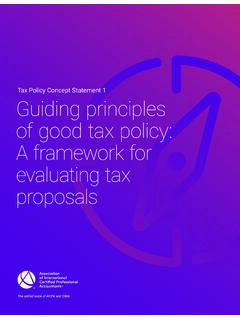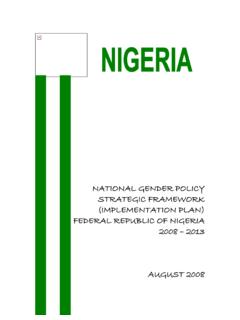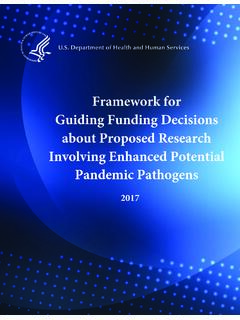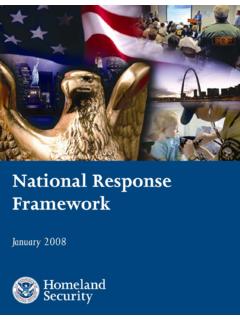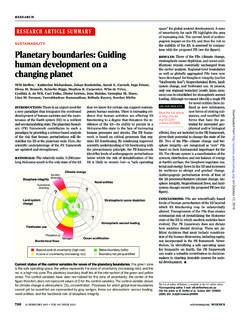Transcription of Sustainability: Definition and Five Core Principles
1 sustainability : Definition andFive core PrinciplesA New FrameworkMichael Ben-EliThe concept of sustainable development, as coined by the World Commission on Environment and Development, and with it, the term sustainability itself, have been gaining increasing recognition in recent years all around the world. Widespread use, however, has led to growing ambiguity, so that today both terms are employed within a very broad spectrum of meaning, often to the point of trivialization. The Definition and set of five sustainability Principles proposed below seeks to advance and restore rigor to the ideas underlying the concept of sustainability . Its development was informed by a number of existing frameworks and was inspired, in particular, by the work of R. Buckminster Principles are articulated in a general fashion but can receive specific operational meaning in relation to particular cases, for example: sectors of the economy, development issues, business strategies, investment guidelines, or initiatives taken by individuals.
2 These Principles are expressed in relation to five fundamental domains:The Material DomainConstitutes the basis for regulating the flow of materials and energy that underlie Economic DomainProvides a guiding framework for defining, creating and managing Domain of LifeProvides the basis for appropriate behavior in the biosphere with respect to other forms of Social DomainProvides the basis for social Spiritual Domain:Identifies the necessary attitudinal orientation and provides the basis for a universal code of result is a set of five core Principles , each with its own derived policy and operational implications. The set is systemic in nature, meaning that each domain affects all the others and is affected by each in return. This systemic aspect is fundamental. It reflects the interdependent nature of reality itself. It has far-reaching implications for policy and for any competent attempt at developing a strategy for change.
3 It implies that in seeking a transition to sustainability as the organizing principle in a new world order, a piecemeal approach emphasizing some aspects, while neglecting others is unlikely to yield effective, lasting world society and the world s economy to a sustainable basis is the most significant challenge of our time. This challenge is unprecedented in scope. Its context is the planet as a whole. It requires a fundamental shift in consciousness as well as action. It calls for a fresh vision, a new dream and new approaches for shaping evolving new realities. Earth is exquisitely configured to accommodate life with abundance, but we humans have consistently compromised every vital component of its intricate fabric. This trend must be reversed and a lasting balance ultimate objective of establishing the concept of sustainability as an organizing principle for the planet is to foster a well-functioning alignment between individuals, society, the economy and the regenerative capacity of the planet s life-supporting ecosystems.
4 This alignment represents a particular type of dynamic equilibrium in the interaction between a population and the carrying capacity of its environment. It is this specific equilibrium that must be the focus of a meaningful Definition of , the prevailing Definition of sustainability emphasizes cross-generational equity, which is clearly an important concept, but which poses difficulties, since future generations needs are not easy to define or determine. Anchoring an alternative Definition to the relationship between a population and the carrying capacity of its environment offers superior operational leverage, as it contains a number of key variables, all potentially measurable: population size, rate of resource consumption, impacts on the absorption capacity of sinks, a measure of well-being, and the like. Hence, the following Definition of sustainability , which applies generally to all species populations, and is true in the specific context of human population:SustainabilityA dynamic equilibrium in the process of interaction between a population and the carrying capacity of its environment such that the population develops to express its full potential without producing irreversible, adverse effects on the carrying capacity of the environment upon which it equilibrium has been greatly disturbed in our time, with the exponential intensification of human activity and the resulting demand on resources, as well as the generation of waste byproducts that exceed the planet s regeneration and absorption capacities.
5 Together, these factors make the current trajectory of human affairs Principles that follow are grounded in this Definition . They are expressed in relation to five key domains, which represent the primary dimensions of the population-environment of SustainabilityUnderlying PremiseAll the physical processes which provide the basis for human existence are subject to the primary laws of physics, for example, the first law of thermodynamics, which addresses the fundamental conservation of energy in the universe, and the second law, which stipulates the direction of energy events. These laws prescribe the ultimate limits of possibilities in physical systems and, therefore, underlie the productive potential in the use of second law underscores the ultimate increase of entropy and disorderliness in all physical systems. At the same time, there are clearly cosmic processes which work to create and increase order, at least temporarily. These processes are evident on Earth in the manifest progression from simple organic molecules, to individual organisms, to societies, to whole ecosystems, and to human consciousness virtue of the innate ability to apply disciplined intelligence to designing universally advantageous configurations of energy and matter arranging and rearranging components of the physical domain humans have the potential to be powerful agents of order creation.
6 This inherent design ability provides the essential means for ensuring lasting abundance. In spite of the immense possibilities that are achievable by thoughtful superior design creating order and slowing the proliferation of entropy our current industrial infrastructure is wasteful, destructive, fragmented and grossly inefficient. With the appropriate intention, it could be reimagined, redesigned and reconfigured in order to deliver an enduring, regenerative advantage for DomainContain entropy and ensure that the flow of resources, through and within the economy, is as nearly non-declining as is permitted by physical laws. Strive for highest resource productivity Employ regenerative energy sources, and continuously recycle non-regenerative resources Amplify performance with each cycle of use Affect an unbroken, closed-loop flow of matter and energy in a planetary production infrastructure conceived as a whole Control leakages and avoid stagnation, misplaced concentrations or random diffusion of chemical elements during cycles of use Advance a service, performance-leasing orientation for managing durable goodsThe First PrinciplePolicy and Operational Implications14 Policy and Operational ImplicationsUnderlying PremiseEconomies consist of markets where transactions occur, and guiding frameworks by which transactions are evaluated and decisions about economic commitments are made.
7 Often treated as though they reflect an independent, objective reality, such frameworks ultimately represent human constructs rooted in values, biases, and dominant interests and concerns. These latter factors determine the adoption of the underlying economic perspective: whether focused on short-term, linear and narrow objectives, or on long-term, comprehensive, eco-sensitive cycles of accounting framework presently used to guide our economy grossly distorts values. It systematically ignores important cost components, like the impacts of depletion and pollution, for example. Economists are beginning to reflect on the inadequacies inherent to the narrow concept of growth that dominates measurement of national economies, and some even highlight the basic absurdity of counting consumption as if it were income, a common practice in the way we treat natural measurements and the regulations and subsidies that often accompany them drive markets and continue to fuel the destructive effects of the economy as a whole.
8 The prevailing conventions of our accounting framework exacerbate such effects and limit the scope of individual initiatives seeking better practices. This self-reinforcing pattern is clearly one key dimension requiring radical Economic DomainAdopt an appropriate accounting system to guide the economy, fully aligned with the planet s ecological processes and reflecting true, comprehensive biospheric pricing. Employ a comprehensive concept of wealth related to the simultaneous enhancement of five key forms of capital: Natural, Human, Social, Manufactured and Financial Align the world s economy with nature s regeneration capacity and incorporate critical externalities in all cost and benefit accounts Embody a measure of well-being and human development in economic calculations Design regulation and taxation policies to accentuate desirable and eliminate adverse outcomes, optimizing the whole Rely on market mechanisms transparent and calibrated to reflect true costs for allocation of capital assetsThe Second Principle25 Underlying PremiseThe adaptive success of our species and its quick propagation almost everywhere on Earth comes at the expense of many other forms of life.
9 The destruction of individual animals, species, habitats and whole ecosystems a trend now reaching ominous proportions is a deep cause for , self-organizing, living systems brains, societies, and ecosystems including rainforests, coral reefs, and industrial economies alike depend on their very complexity, their internal variety, for long-term viability. Lasting stability in all such systems, science tells us, is in fact a direct function of complexity, of an inherent redundancy, which allows for the emergence and reemergence of different configurations in response to changing events. Monocultures, by contrast, are brittle in principle the antithesis, in this context, of vibrant this point, contemporary science seems to converge with the intuition of many of the world s ancient wisdom traditions, which insist on the uniqueness and fundamental sacredness of all forms of LifeEnsure that the essential diversity of all forms of life in the biosphere is maintained.
10 Assume responsible stewardship for our planet s web of life Harvest species only to regeneration capacity Conserve the variety of the existing gene pool Shape land use patterns to reduce human encroachment on other forms of life and enhance biological diversity in areas of human habitatThe Third PrinciplePolicy and Operational Implications36 Policy and Operational ImplicationsUnderlying PremiseWork of early 20th century scientists, mathematicians, and philosophers of science brought to the fore the fundamental fallibility of human knowledge, questioning the notion of an ultimate truth. This suggests that, in true ecological fashion, myriad expressions and species of truth should be allowed to coexist without any particular one seeking to aggressively dominate findings in the neurological sciences point out that the human nervous system is more plastic than heretofore believed. It seems that neural circuits, conditioned by past experiences to emphasize fight or flight behavior, can be retrained by persistent individuals efforts to favor those higher centers of the brain, which regulate for a more inclusive, compassionate stance.


